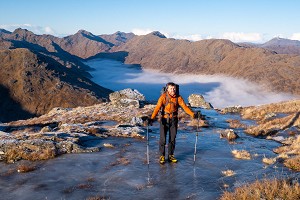
Dan Bailey reviews three synthetic insulated jackets, made by UK-based brands, and built (albeit not in Britain) with the soggy British cold in mind. He finds the Montane Flux, Rab Generator Alpine and Mountain Equipment Fitzroy are just as good for walkers as climbers.
At the risk of stating the obvious, your choice of insulation should match the conditions you're expecting. In the Himalaya I'd go for down and no questions asked, but in the British winter moisture would usually be more a concern than extreme low temperatures. The big advantage of synthetic insulation over down is that it still performs (after a fashion) when wet, so synthetic insulated jackets are well suited to the sort of conditions generally met when walking and climbing in our winter mountains.
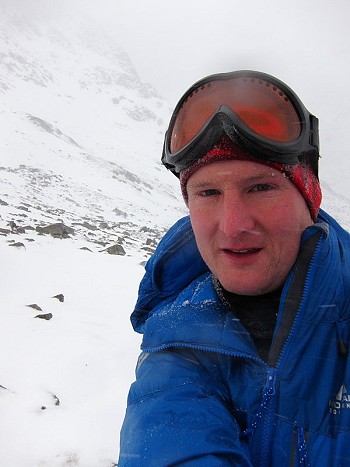
The three jackets on test here aren't meant to be stand-alone insulation pieces for real arctic cold (minus double digits, say), but are best treated as a lightweight, low-bulk warmth booster to slip over a few other layers. For over-layering a jacket needs to be adequately roomy. It should also be weatherproof - if not genuinely waterproof – since it'll be exposed to the outside elements and might well be sitting on top of an already-wet waterproof too.
Synthetic duvets are often called belay jackets, and that's an obvious application; but don't typecast them. I often wear mine all the way up winter climbs - not just for belays but on the pitches too, where the chilly shade of a north-facing crag and the stop-start rate of progress can keep overheating to a minimum. And this sort of jacket is equally useful for hillwalkers. In colder weather all three of these jackets are light enough to wear while walking (perhaps not when steaming uphill), and they're also ideal over-wear on a windy summit stop. Walkers are often urged to carry spare warm clothing just in case, and in an emergency there'd be nothing better than a big duvet that you can just shove on over everything else.
More heavily-insulated synthetic jackets are available, but the three lightly-stuffed models reviewed here strike a good balance between warmth, weight and packability, and they can be worn on the go as well as when stationary. All three are from UK-based firms, and built (albeit not in Britain) with the soggy British cold in mind. Though aimed primarily at climbers these jackets are just as suited to winter walking; rather better, in some respects. They are broadly similar in look, weight and performance, all with Primaloft inside and tough, lightweight, weather-shedding outers. However, though they're reasonably subtle the differences become clear in use.
"The three jackets reviewed strike a good balance between warmth, weight and packability, and they can be worn on the go as well as when stationary."
Each jacket has been used on at least a few days out this season, hillwalking, winter climbing and in one case for a bivvy. Of course different days bring different weather, and since I haven't tested them under controlled conditions in a wind tunnel or a giant freezer my impressions of warmth and weatherproofness are just that – impressions.
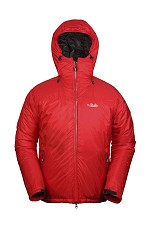
Rab
Generator Alpine
- RRP £150
- Weight 561g (size L, my measurement)
- Outer 30D Pertex Endurance
- Lining 20D Pertex Quantum
- Insulation 100gsm Primaloft One in body; 60g in arms and hood
Rab website
Zip: The YKK weather resistant 2-way main zip with anti-snag draft-excluding internal baffle seems less heavy-duty than those on the other two jackets, and this sort of detail may help account for the Generator Alpine's lighter weight. I've not yet been able to damage it, so this may have been a weight saving worth making. However it is slightly more prone to sticking than the zips on the other two jackets. As on the rival models the baffle folds over at the top to keep the zipper off your chin.
Pockets: The two hand pockets are quite low on the body, so almost totally obscured by harness or rucksack hip belt. The zips are weather-resistant, again with with an anti-snag strip inside. The pocket linings are utilitarian Pertex, not coddling fleece. The compromised access to the lower pockets is partly compensated by the roominess of the single chest pocket, which is adequate for holding a few bits and bobs when on the move. This pocket has a non-weather-resistant zip (why not?), but it's protected with a slightly stiffened storm flap. There's one pretty big inside chest pocket too; but what are you really going to keep in there?
"For me, the Generator Alpine offers the best-performing hood of the three when wearing a helmet..."
Cut: The Generator Alpine is fairly long in the body, more so at the rear where it covers most of the bum. This length feels nice and snug, and helps stop the jacket riding up out of your harness when climbing. There's a drawcord hem with toggles at the sides.
Sleeves: These are long enough that I can pull my hands right in when walking glove-less, and good for raising arms when climbing. There's a simple perfectly functional Velcro cuff tab. The sleeves are cut roomy enough to layer over waterproofs, but only just. It's not a major problem, but when worn over several layers I find them slightly close-fitting when bending the elbow.
Hood: There's bags of space for a helmet, and the hood moves well with the head either with or without a lid – even when looking straight up. The volume and face hole can of course be reduced for a snug fit when un-helmeted. The side and rear adjustment toggles are operable wearing gloves (within reason). However when the face-hole is cinched extra tight the drawcord tails are long enough to whip you in the face in high wind, and there's no way to secure them. All three jackets share this issue. There's a wired peak (de rigeur), a roll-away Velcro tab and full-face fleecy internal chin guard, much larger than those on the rival jackets. For me at least this is the best-performing hood when wearing a helmet, though perhaps different hoods best suit different head or helmet shapes?
Fabric: According to Rab's designers the lightweight, packable Pertex Endurance outer 'has a light coating making it water proof to 1000mm, but still breathable. This makes it a good option for a shell on a Primaloft belay jacket because Primaloft One already has great water resistant qualities so a totally waterproof fabric would be overkill in most situations.' Meanwhile, the Pertex Quantum inner 'is super lightweight and packable and is also slippy to make it easy for pulling on over other garments. It has a DWR to help prevent moisture absorption.' Both fabrics are highly windproof, and seem to work as promised.
Filling: Primaloft One has a degree of wind and water resistance, and holds heat well when wet. I find the 100g per square metre weight used in the body to be just adequate when stationary, but not necessarily overkill for moving. The 60g filling in hood and arms helps reduce any possible clamminess.
In use: As the lightest of the three jackets this seemed well suited to a two-day bivvy/backpack/easy gullies trip around the Cairngorms, as it wouldn't add too much to my already onerous load. On day one we dumped the sacks for an evening snow plod in Coire Sputan Dearg. The Generator Alpine went straight over my T-shirt and long sleeved base layer. Its chest pocket easily swallowed a headtorch and snacks – all the extras I'd need. I didn't feel overdressed when steaming up the lower slopes. Towards the top of our grade I gully progress slowed when iffy snow encouraged us to get roped. I stayed toasty when standing at the belay in a chill sunset. Having retrieved the sacks we made a high bivvy on shelter-free, wind-scoured icy ground. The night was benign enough for this sort of daftness, but still very much sub zero (unsurprisingly). Now we'd really stopped moving the limitations of this lightweight jacket were immediately obvious; I added a mid weight fleece under it and a waterproof jacket on top, for the hour or two of milling about before retreating to the sleeping bag.
Summary: The Generator Alpine is the lightest of the three jackets. Its weight is a bonus for carrying, but also means that it's (marginally) the least warm. Outside the winter season this is probably a bonus, and especially so if you're going to be wearing it on the move when hillwalking. For climbers it has the best hood, but the hand pockets are too low to be much use with a harness or hip belt. It's fairly priced.
<div class="box left style=" width:45%"="">

Mountain Equipment
Fitzroy
- RRP £170
- Weight 648g (size L, my measurement)
- Outer DriLite Loft II
- Lining Ultrasoft (except hood and hem in DriLite Loft II)
- Insulation 100gsm Primaloft One in body (plus some double-layering at the front); 60g in arms and hood
Zip: Robust and chunky two-way main zip with internal anti-snag draft-excluding baffle, which folds over the top of the zip to avoid scratching the chin.
Pockets: Two laser-cut and bonded hand pockets, placed slightly higher on the body than the Rab's. Mountain Equipment claim these can be used when wearing a harness or hip belt, but I beg to differ - in this situation they're practically inaccessible. These pockets aren't huge, but are snugly fleece lined, a nice little luxury. There's also a single Napoleon-style chest pocket, again laser cut and bonded, and roomy enough for hat and gloves or an OS map. Finally there's a single internal chest pocket, which I doubt I'd often use.
Cut: Quite long in the body for maximum coverage, including most of the bum; on me the jacket fits well under a harness or rucksack hip belt, and isn't hugely prone to ride up when climbing. There's a drawcord hem with side adjustment toggles.
"Though the three jackets are a similar weight I feel (marginally) warmest and best protected from the elements in the Fitzroy..."
Sleeves: Long in the arms too – again ideal when climbing or for those days you just want to retract your hands as far inside as possible. The sleeve cuffs are cut on a slight diagonal; if this is supposed to help keep the back of the wrists covered when the cuffs are tightened then it seems to work. Adjustment is a simple Velcro tab. The arms are cut roomy enough for over-layering, and when doing so feel just a tiny bit less restrictive than the other two jackets on test; the difference can't be more than a couple of millimetres though.
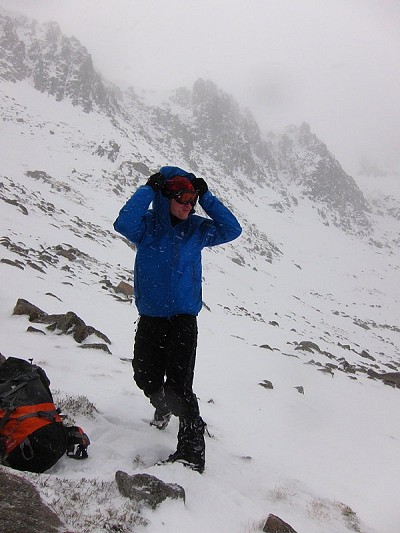
Hood: Sized to accommodate a helmet, though for this it has a slightly tighter feel than the Rab's. When you're helmet-less it's easily adjusted for volume. Either helmeted or not, the hood moves well with my head side-to-side, but with a lid on and the hood fully zipped the full head-back position feels slightly hampered and my chin tends to pop out. The hood's adjustment toggles are internal, and once you've got used to that they're slightly less fiddly than the conventional external arrangement; again, those unsecured drawcord ends can occasionally ping you in the face. There's a roll-away Velcro tab. The wired peak works well in the wind. Though the fleecy chin guard is only narrow there's enough of it for a snug feeling. Overall it's a good protective-feeling foul weather hood. The fit is hard to fault for hillwalking use, while for climbing it's not quite as helmet-friendly as the Rab's but better than the Montane's.
Fabric: ME's own DRILITE Loft II is used throughout the exterior to give a shell that really shrugs off the elements. 'This is a coated fabric which provides the optimum balance of weatherproofing, breathability and light weight' ME's Duncan Machin tells me. 'It has a 1.5m hydrostatic head that ensures you are protected from melting spindrift and damp winter conditions whilst being sufficiently breathable to prevent moisture build up, even if days out exposed to the elements turn to weeks.' A more breathable UltraSoft fabric is used inside, while ME have reverted to Drilite Loft II for the lining of the hood and inside the bottom hem. This is a good move, since the overlap with the trousers can often get a bit damp, while your hood has generally filled with snow before you remember to put it up. Though I've not yet managed to poke a hole in any of the jackets the Fitzroy feels like it has the most robust fabric, and it's the one I'd choose on a wet day too.
Filling: Primaloft One is used throughout, as for the other jackets with 100g weight in the body and 60g in the arms and hood. I think this ratio is a good compromise for a lightweight jacket, but when stationary it is really only just enough (if that, sometimes). Warmth-wise the Fitzroy has an advantage over the Generator Alpine however, because the pockets are 'lined' inside and out with 100g Primaloft, giving a welcome double layer of 200g insulation over much of the front of the body.
In use: I packed the Fitzroy for a day of avalanche dodging on Hell's Lum. It was too warm for the walk-in of course, but on gearing up I layered it over a base layer and a normal weight VapourRise jacket, dispensing with the shell I might normally wear against wind and spindrift. By about halfway up the route waves of the latter were periodically pouring over us, building up on every surface and trying to find a way into mouth, nostrils and every chink in our clothing, carried on quite a nippy breeze. One belay in a spindrift channel seemed to go on for eternity. As each wave hit I hunched into my jacket, thankful for its snug protection. The roomy wired hood kept the worst at bay, and the long cuffs helped me retain feeling in my hands. Ropes and slings had frozen into stiff cables. I won't say I wasn't frozen stiff too, but thanks to the Fitzroy it could have been much worse.
Summary: Though the three jackets are a similar weight I feel (marginally) warmest and best protected from the elements in the Fitzroy, with its long-ish cut, extra front insulation and robust weather-shedding outer fabric. It's a decent all-rounder, great for walkers and OK for climbers. The main pockets are quite compromised with a harness or hip belt though, and for helmet wearers the hood could be ever so slightly roomier as its freedom of movement is not as complete as the Rab's. Compared to the other two jackets the price is nudging towards expensive too.
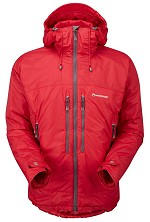
Montane
Flux
- RRP £140
- Weight 628g (size XL, my measurement)
- Outer Pertex Microlight Rip-stop
- Lining PEAQ Synthetic
- Insulation 100gsm Primaloft Eco in body (160g in chest area); 60g in arms and hood
Montane website
Zip: As with the Fitzroy this is another chunky two-way zip which feels like it'll really last the distance. The draft-excluding inside baffle has an anti-snag strip, and there's a fold-over chin guard.
Pockets: You couldn't ask for more. This jacket boasts two very large hand pockets, plus two Napoleon-style chest pockets which are a little smaller but still generous enough to fit an OS map; there's even an internal pocket too (again, I doubt I'd use it much). The hand pockets are placed higher on this jacket than those of the other two on test, and can be easily accessed when wearing a harness or rucksack hip belt. All five pockets can be used when you're on the move - a major advantage over the rivals. All the pocket zips are that same chunky robust design as the main zipper, and though they lack anti-snag strips I've so far failed to find this a problem.
Cut: The body of the Flux is generous in the width for easy layering. Lengthways there's decent bum coverage but at the front this jacket is marginally shorter than the other two on test. This is a drawback in the cold, when every inch counts (I'm told). Because of this the Flux is also a little too keen to ride up out of my harness when climbing. Perhaps it's partly that Montane's sizing just doesn't suit me well – the other two jackets on test are a size L, but with the Flux anything less than XL is way too short on my body. There's a drawcord hem with side adjustment toggles.
"If you like lots of pockets this is the jacket for you, particularly since they're all accessible when wearing a harness or hip belt - and when aren't you?"
Sleeves: Is the average climber built like an orang utan? I didn't think I was unusually long in the body and short in the arms, but while I wish there were a little more length at the waist of the Flux, my hands almost completely disappear inside its sleeves – I've inches of material to spare here, enough to get in the way at times. It's fine if the Velcro wrist tabs are tightened of course, and does allow an unhindered high reach. As with the Rab, when worn over several layers I find the sleeves a teensy bit close-feeling when bending the elbow.
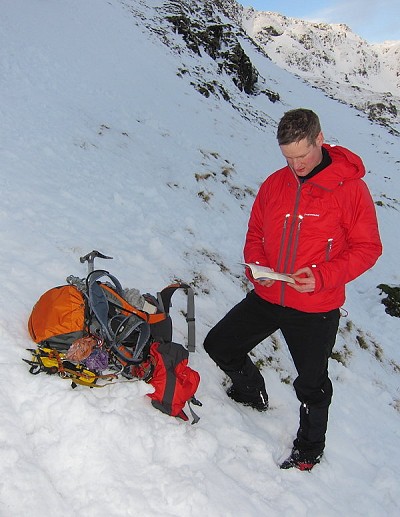
Hood: Given Montane's climbing heritage, the Flux's hood rather lets it down. It's sizeable enough to fit a helmet, but only just. For me at least, the whole hood has to rise to accommodate it - so much so that with the zip fully sealed the lower face is covered right up to the nose. When I'm totally zipped up, side-to-side helmeted head movement is quite badly restricted, and I have to try very hard to look directly upwards at all. Unzip below the chin and movement is much eased; fine unless the weather's really foul (that's quite a lot of the time, though). Walkers needn't worry about this. Without a helmet there's plenty of room, the volume is easily adjusted to suit, and the hood is more inclined to move with the head. As with the Generator Alpine the adjustment toggles are external. The Flux shares the same defect as the other two jackets in that there's nothing to secure the drawcord ends and prevent them from occasionally whipping you in the face in a gale. There's a wired peak, a roll-away Velcro flap and a narrow but adequate fleece chin panel. For general winter hillwalking it's a decent hood, and certainly keeps the weather out; but it's not brilliant for helmet wearers. Or perhaps I've just got a big head (along with my stumpy arms and long trunk)?
Fabric: The Pertex Microlight Rip-stop outer is billed as completely windproof, fast drying and showerproof (with a 'spray rating' of 80/20; I'm not sure how this equates to hydrostatic head as measured on the other two jackets). It also boasts a decent durable water repellency (DWR) treatment. I've not exposed it to wet enough weather to test its limits as yet, though a rigorous kitchen sink test was positive. The Pertex of the outer is folded quite far up inside the hem, helping keep the jacket dry when your trousers aren't; likewise inside the hood, a nice touch that the Flux shares with the Fitzroy. Inside it's something called PEAQ Synthetic, silky smooth and definitely on the breathable side. Back outside, the little reflective strips on the Flux are a good idea when walking along the verge of the A82 after dark.
Filling: The Flux is the only jacket of the three to use Primaloft Eco (min 50% recycled content); I can't say I notice a difference in use. As with the other jackets on test the 100g weight in the body and 60g in the arms and hood are just adequate when stationary without being excessive on the move. There's a nifty over-layering in the pocket region with two panels of 60g Primaloft, one in front and the other behind the pockets. This gives a total 120g thickness over your chest and belly, just where it's appreciated (your rucksack helps insulate the lighter-clad back after all).
In use: With a high wind forecast on our only weekend climbing day, we headed to a sheltered sun trap in the Southern Highlands. Yes it was a bit drippy in places, but at least I topped up my tan. The Flux went on over a couple of base layers when gearing up, then stayed on for the climb because I'm too lazy to keep changing layers. Of course I worked up a sweat when moving; that's what zips are for. Being old traditionalists we capped our climb with a walk to the nearest summit, now fully exposed to the biting gale. Despite the marked drop in temperature I stayed toasty (though not too hot) in the Flux and even appreciated the extra-long hand-swallowing cuffs. Better still were the spacious pockets. Because they remain accessible whatever you're doing I didn't have to stop and faff to retrieve my warmer gloves.
Summary: Weight and warmth-wise, the Montane Flux is a good halfway house; with its double front insulation it's slightly warmer than the Generator Alpine, but there's less extra filling than in the Fitzroy. If you like lots of pockets this is the jacket for you, particularly since they're all accessible when wearing a harness or hip belt - and when aren't you? Pocket accessibility should be a given with this sort of jacket, not the exception. I'm not a fan of the cut, but for someone somewhere it must be ideal. The hood is good for walkers but sadly a headache for climbers, simply too tight to accommodate a helmet and permit decent head movement. Nice price though.
Conclusion:
In colder conditions I'd favour the jackets in order of their insulation - the Fitzroy first, then the Flux and lastly the Generator Alpine. Conversely, for wearing on the go or outside the winter months the slightly lighter-insulated Rab jacket would come into its own. The difference in warmth is really fairly marginal though. All three are excellent jackets for general use and can barely be faulted for winter hillwalking, but each has its little niggles when climbing. To best meet the needs of climbers I feel the perfect synthetic jacket would actually be a hybrid of the three, combining the Generator Alpine's hood, the Fitzroy's fabric and slightly boosted insulation, and the Flux's pockets and price.



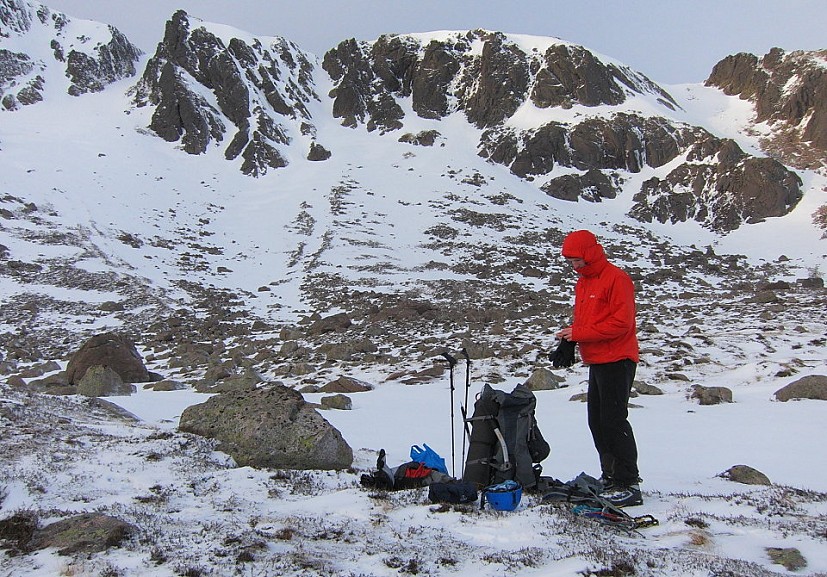
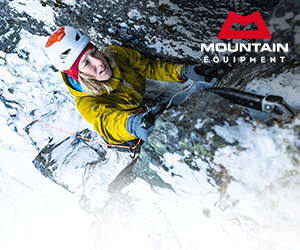
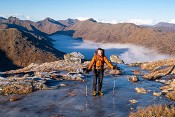


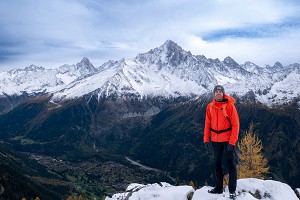

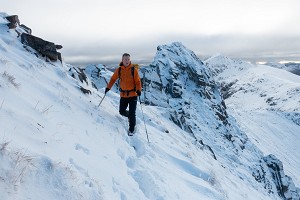

Comments